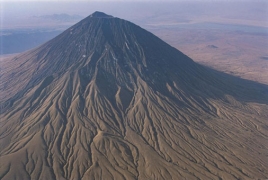
An active volcano in northeastern Tanzania known to the Maasai as the “Mountain of God” has been quietly rumbling—and it is showing signs that an eruption is imminent, National Geographic reports.
Known as Ol Doinyo Lengai, the 7,650-foot-tall peak is the only known active volcano that belches out lava rich with a type of rock called carbonatite. This thin, silvery lava can flow faster than a person can run. (Read more about the volcano from our January 2003 issue.)
The volcano is some 70 miles from the city of Arusha and is known for its proximity to some of the world’s most important paleoanthropological sites. Ol Doinyo Lengai is less than 70 miles from the famed Olduvai Gorge, a collection of 3.6-million-year-old hominin footprints at a site called Laetoli, and a “dance hall” of ancient Homo sapiens footprints at a site called Engare Sero.
Typically, the volcano’s activity is confined to its summit. But occasionally, the Mountain of God can roar to life in more dramatic fashion: On September 4, 2007, the volcano belched out a plume of ash that extended at least 11 miles downwind. Lava running down the north and west flanks ignited burn scars that were visible from space.
D. Sarah Stamps, a geophysicist at Virginia Tech, has been partnering with local academics to try and predict the next major eruption. In June 2016, she and her colleagues installed five positioning sensors around Ol Doinyo Lengai in the hopes of tracking how magma’s underground churn is deforming the volcano’s surface.
In concert with Tanzania’s Ardhi University and South Korea’s KIGAM, Stamps has set up a monitoring system that collects data on the volcano’s activity in real time.
On January 17, 2017, Stamps saw a shudder in the data streaming from one monitoring station—a sign that, far from merely rumbling, parts of the volcano were lifting upward.
“Several subsequent signals were also seen in real-time with additional on-the-ground observations by our local technician,” Stamps says. “These signals prompted rapid responses by our team to install three new real-time stations”—a project funded by the National Geographic Society. (Since 2012, the National Geographic Society has committed more than $400,000 to researching volcanoes. Find out more.)
Based on the data they are seeing, Stamps and her colleagues warn that an eruption seems to be on the horizon.
“Imminent in our case means in one second, in a few weeks, a couple of months, or a year or more,” she says in an email.
“There are increased ash emissions, earthquakes, uplift at small volcanic cones, and an ever widening crack at the top of the volcano on the west side,” she adds. “These are all signs of volcanic deformation that will likely lead to an eruption sooner rather than later.”

